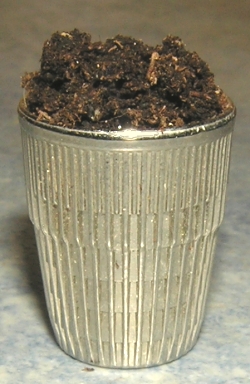DISCUSSION OF WHERE FUNGI GROW AND WHAT THEY ARE DOING THERE

One of the tasks set for mycology students at the University of Toronto was to enumerate and identify the fungi living in a thimble-full of forest or garden soil. To do this they prepared cultures in Petri dishes from their thimble of soil and used their results to make generalizations about what was growing there. The methods they used were highly error-prone but nevertheless yielded interesting results. What they found was that a single thimble-full of soil (3.5 cc) contained anywhere from 25,000 to a million fungal spores. A second sample collected close to the first one might yield similar numbers but many of the fungi were different. The final conclusion reached by most of the students was that a mass of soil the size of a thimble was so complex that they couldn't really become very familiar with the fungi that were living there. The scale of fungal life there is so small that the methods they were using, including the idea that a thimble-full of soil represents a workable fungus habitat, are akin to studying wildflowers from an airplane.
To really appreciate the habitats and activities of fungi you must get your mind down to their scale. Of course some fungi are large and appear to operate at our scale, but this is not really so. When you suddenly find your foot falling through a wooden deck rotted by fungi you may think of them as occupying a space strongly overlapping your own, but in fact that same fungus has a busy micro-life in your deck catching and consuming small invertebrate animals and even the spores of other fungi. It finds new decks to grow on not by walking around until it finds one but by releasing spores no larger than the ones found by the students in their thimble of soil.
|
FOR THOSE WHO LOVE WACKY FACTS AND FIGURES Suppose the thimble of soil, containing a modest 100,000 fungal spores, could be enlarged to the size of a water tank measuring 20 meters high by 15 meters in diameter, that is, exactly 1000X the dimensions of the original. For simplicity, assume the thimble is cylindrical and the spores spherical. Assume also that the spores, originally 10 micrometers in diameter (1000 micrometers = 1 millimeter) are enlarged 1000X their original diameter and are spaced uniformly throughout the soil sample. Now, suppose you could remove the soil but leave the spores suspended and could walk around inside the tank. How big would the spores be? How far apart would they be? Could you walk around inside the tank and avoid running into the spores? |
Getting back to the soil sample, if we study it very closely; if we look at each of the fungi that grow there, noting their nutritional preferences, their interactions with other microbes, how they reproduce, we find that each plays out a very specific role in the soil and that the soil itself is nothing more than a general environment. The fungi in that sample of soil may have no more in common with each other than a jellyfish and a shark have in the sea. And just as a marine biologist must make careful observations in the sea, a mycologist must examine each fungus closely at its own minute level to see what it is really doing.
Fungal ecologists classify fungal activities in a number of ways. Because fungi lack photosynthesis and like animals must find their food somewhere in their environment they can be subdivided according to their modes of nutrition. Thus some fungi obtain nutrition from other living organisms while many others consume organic material that is already dead. On this site we have chosen to present fungi as parasites, mutualists and saprotrophs. PARASITES prey on other living organisms, growing and reproducing at their expense. MUTUALISTS also obtain nutrients from other organisms but give something back in return. SAPROTROPHS are the clean-up crew, growing on the remains of organisms that have previously died.
There are gray areas here. Some fungi may function as parasites during part of their lives and settle down later to live harmlessly on long-dead debris. Mutualists may become less generous during hard times and begin to function as parasites. Some saprotrophs may bring about the decline or death of the organisms they eventually consume. The best we can do is to say that most fungi can be assigned to one of these lifestyles without difficulty and that most will confine themselves to one activity throughout their lives.